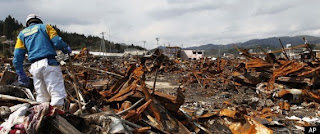What happened to Fukushima in March 2011...?
Japan suffered from worst of the disasters this year. The calamities went worse to the possible levels, as a major nuclear accident accompanied a strong earthquake and a subsequent tsunami. This nuclear accident is considered second only to the worst ever nuclear accident at Chernobyl and is the largest in the history of Japan.
 As Fukushima’s nuclear power station was nearby the coast, it was taken into task by the mighty tsunami. The nuclear power station consisted of six boiling water nuclear reactors maintained by Tokyo Electric Power Company (TEPCO). Out of six reactors, reactor 5 and 6 was been cold shutdown for maintenance, reactor 4 was de-fueled and reactors 1, 2 and 3 were functioning at time of the disaster. The nuclear station was protected by seawalls of height 5.7m (19ft) but the incoming waves were at a maximum height of 14m (46ft).
As Fukushima’s nuclear power station was nearby the coast, it was taken into task by the mighty tsunami. The nuclear power station consisted of six boiling water nuclear reactors maintained by Tokyo Electric Power Company (TEPCO). Out of six reactors, reactor 5 and 6 was been cold shutdown for maintenance, reactor 4 was de-fueled and reactors 1, 2 and 3 were functioning at time of the disaster. The nuclear station was protected by seawalls of height 5.7m (19ft) but the incoming waves were at a maximum height of 14m (46ft). The huge rush of water completely shut down the power systems across the station. Hence, all the cooling machineries of the functioning reactors failed. Due to overheat and natural decay of radioactive substance in reactors 1, 2 and 3, hydrogen explosions occurred. Multiple fires broke out in the reactor 4. As reactors 5 and 6 were not functioning, they are the least affected. Officials declared the accident as level 4 in the International Nuclear Event Scale (INES). Later, the declaration was upgraded to 5 and then to 7, which is the maximum.
The huge rush of water completely shut down the power systems across the station. Hence, all the cooling machineries of the functioning reactors failed. Due to overheat and natural decay of radioactive substance in reactors 1, 2 and 3, hydrogen explosions occurred. Multiple fires broke out in the reactor 4. As reactors 5 and 6 were not functioning, they are the least affected. Officials declared the accident as level 4 in the International Nuclear Event Scale (INES). Later, the declaration was upgraded to 5 and then to 7, which is the maximum.
Fukushima is a major industrial town in the northwest coast of Japan.. On 11, March 2011, an earthquake with reading 9 on the Richter’s shook areas close to Tokyo, having its epicenter on the islands of Honshu. This earthquake drove a series of huge tsunami waves to the coastal areas present around.
 As Fukushima’s nuclear power station was nearby the coast, it was taken into task by the mighty tsunami. The nuclear power station consisted of six boiling water nuclear reactors maintained by Tokyo Electric Power Company (TEPCO). Out of six reactors, reactor 5 and 6 was been cold shutdown for maintenance, reactor 4 was de-fueled and reactors 1, 2 and 3 were functioning at time of the disaster. The nuclear station was protected by seawalls of height 5.7m (19ft) but the incoming waves were at a maximum height of 14m (46ft).
As Fukushima’s nuclear power station was nearby the coast, it was taken into task by the mighty tsunami. The nuclear power station consisted of six boiling water nuclear reactors maintained by Tokyo Electric Power Company (TEPCO). Out of six reactors, reactor 5 and 6 was been cold shutdown for maintenance, reactor 4 was de-fueled and reactors 1, 2 and 3 were functioning at time of the disaster. The nuclear station was protected by seawalls of height 5.7m (19ft) but the incoming waves were at a maximum height of 14m (46ft). The huge rush of water completely shut down the power systems across the station. Hence, all the cooling machineries of the functioning reactors failed. Due to overheat and natural decay of radioactive substance in reactors 1, 2 and 3, hydrogen explosions occurred. Multiple fires broke out in the reactor 4. As reactors 5 and 6 were not functioning, they are the least affected. Officials declared the accident as level 4 in the International Nuclear Event Scale (INES). Later, the declaration was upgraded to 5 and then to 7, which is the maximum.
The huge rush of water completely shut down the power systems across the station. Hence, all the cooling machineries of the functioning reactors failed. Due to overheat and natural decay of radioactive substance in reactors 1, 2 and 3, hydrogen explosions occurred. Multiple fires broke out in the reactor 4. As reactors 5 and 6 were not functioning, they are the least affected. Officials declared the accident as level 4 in the International Nuclear Event Scale (INES). Later, the declaration was upgraded to 5 and then to 7, which is the maximum. The magnitude of releases of Iodine-131 and Ceasium-137 isotopes in Fukushima was found to be in same order as the releases in Chernobyl accident were. The soil was announced to be contaminated by Plutonium isotopes. Food from the region was not allowed to be sold. The radioactive pollution required an evacuation of about 20km radius. All the workers were hospitalized as a precaution and were found to be exposed between 2000 and 6000 mSv of radiation at their ankles, as they were standing in the contaminated water for control measures.
The whole town of Fukushima was devastated as the water got past the reactors and flowed through the mainland. Everything on the way was just flooded back into the sea. Japanese government and TEPCO have been criticized for poor public communications. But, every of the remedy steps were been taken immediately. However, the assault of nature over Fukushima and in turn, Japan was very brutal…


Comments
Post a Comment